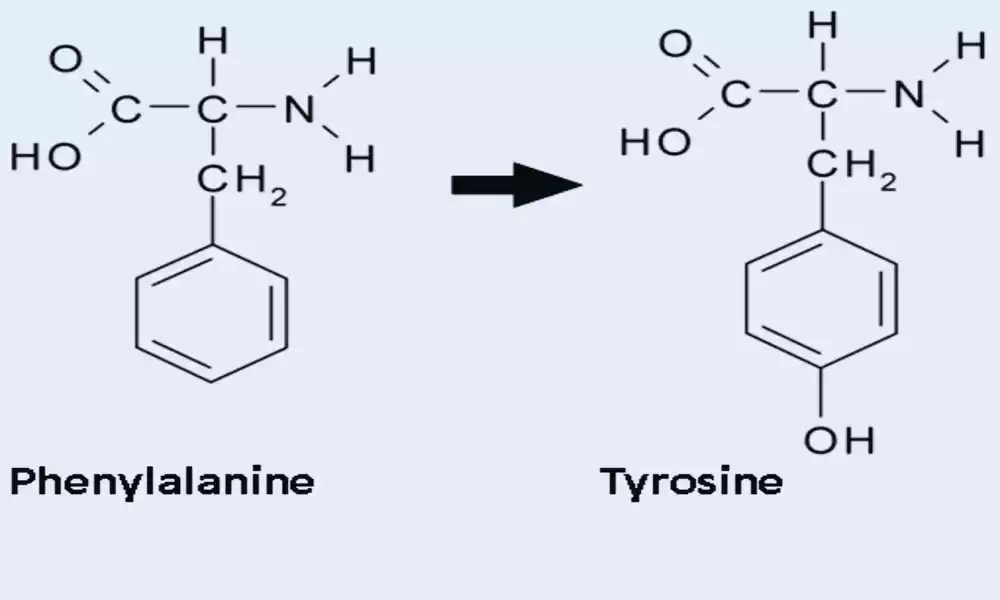Phenylalanine takes the spotlight as an essential amino acid, a VIP that our body can’t whip up on its own. It must be exclusively invited to our diet. Phenylalanine holds the key to a remarkable transformation.
Tyrosine, In this tale, tyrosine emerges as the adaptable one. It’s a nonessential amino acid, quite the opposite of phenylalanine. And here’s the twist – tyrosine is born from the very essence of phenylalanine within our body.
Imagine a cast of twenty distinct amino acids, each with its unique role. Some, like phenylalanine, play hard to get, demanding an entrance ticket from our meals. Others, like tyrosine, are more down-to-earth, ready to emerge from within.
What’s intriguing is that these two amino acids, phenylalanine and tyrosine, belong to the aromatic family, adding a touch of allure to their character. They serve as essential building blocks for various compounds within our body, fueling the intricate dance of life.
What is Phenylalanine?
Phenylalanine, one of the many intriguing characters in the world of amino acids, plays a crucial role in our body’s intricate biochemical drama. This remarkable amino acid is considered “essential,” not because it demands the spotlight, but because our body can’t produce it on its own, making it an essential member of our dietary ensemble.
In essence, phenylalanine is the silent architect behind a vital transformation. It serves as a precursor for another amino acid, tyrosine, in a metabolic metamorphosis within our body. This process is like a symphony of biochemical reactions, where phenylalanine takes center stage and orchestrates the production of tyrosine, a nonessential amino acid. Tyrosine then goes on to perform various essential functions.
But phenylalanine’s story has a dramatic twist. In some cases, phenylalanine can be a protagonist in a health challenge known as phenylketonuria (PKU). In this tale, individuals with PKU must watch their phenylalanine intake with vigilance, as their bodies cannot properly metabolize this amino acid. Excessive phenylalanine in their diet can lead to severe health consequences.
Yet, in the grand narrative of our biochemical processes, phenylalanine continues to play a significant role. It’s found in various dietary sources, from protein-rich foods to certain artificial sweeteners. It quietly influences the creation of tyrosine, participates in protein synthesis, and contributes to the intricate dance of life within our bodies.

Phenylalanine may be an understated character in the amino acid story, but its presence is vital to the ongoing biochemical saga that sustains our health and vitality. It’s a reminder that even the seemingly modest components of life’s grand chemistry can hold immense importance.
Role in protein synthesis of Phenylalanine
Phenylalanine, a vital player in the orchestra of protein synthesis, contributes significantly to the formation of the complex structures that make up our bodies. As one of the 20 standard amino acids, phenylalanine has its unique role in this intricate biochemical symphony.
Here’s a closer look at its role in protein synthesis:
1. Building Blocks of Proteins: At the core of protein synthesis are amino acids, and phenylalanine is one of these foundational building blocks. In the ribosome, the cellular machinery responsible for protein assembly, phenylalanine steps onto the stage during the translation process, which is the second stage of protein synthesis.
2. Codon Recognition: In the language of genetics, phenylalanine is represented by specific codons, which are sequences of three nucleotides in the messenger RNA (mRNA). Each codon corresponds to a particular amino acid. Phenylalanine has its unique codons, like UUU and UUC.
3. Transfer RNA (tRNA): Transfer RNA molecules, often referred to as “adapter molecules,” serve as interpreters in the protein synthesis process. They recognize the mRNA codons and bring the corresponding amino acids to the ribosome. For phenylalanine, there’s a specific tRNA molecule with an “anticodon” that pairs with the UUU or UUC codon.
4. Peptide Bond Formation: Once phenylalanine is in position, the ribosome orchestrates the formation of peptide bonds between phenylalanine and the preceding amino acid. This process continues as the ribosome moves along the mRNA strand, linking amino acids together in the precise order dictated by the genetic code.
5. Polypeptide Chain Elongation: Phenylalanine’s role doesn’t end with the formation of a single peptide bond. It’s a part of a more extensive chain reaction where polypeptides, which are chains of amino acids, extend and fold into the unique three-dimensional structures of proteins.
In this intricate process, phenylalanine, like all amino acids, contributes to the distinct sequence and composition of each protein. The specific arrangement of phenylalanine and other amino acids determines a protein’s function, shape, and role in the body. This diversity of protein structures is what underpins the incredible complexity of living organisms, and phenylalanine plays a vital part in this grand biochemical production.
What is Tyrosine?
Tyrosine, a prominent figure in the vibrant world of amino acids, has a story that’s quite different from its predecessor, phenylalanine. Tyrosine is not one to wait for an invitation; it’s a “nonessential” amino acid, which means our body has the impressive capability to produce it all on its own.
This amino acid with a can-do attitude arises as the result of a fascinating transformation. It’s born from phenylalanine, another amino acid that’s essential but requires an external introduction through our diet. In a splendid biochemical ballet, phenylalanine donates a portion of itself, and voilà, tyrosine takes center stage.
Tyrosine doesn’t stop at being self-sufficient. It goes on to play a series of remarkable roles in the body. This multitasking amino acid is a crucial building block for various essential compounds, including neurotransmitters like dopamine, norepinephrine, and epinephrine. These neurotransmitters influence our mood, stress response, and overall well-being.
But tyrosine doesn’t just shine in the realm of mood regulation. It’s also a key player in the synthesis of thyroid hormones, which control our metabolism and energy levels. This makes tyrosine’s contributions even more far-reaching.

So, while tyrosine might be considered nonessential in the amino acid lineup, it certainly doesn’t take a backseat in the grand scheme of our biochemical story. It’s an amino acid that showcases the body’s remarkable ability to craft its own essential components, all the while supporting functions that affect our mental and physical health. Tyrosine’s unique journey reminds us of the intricate choreography that takes place within our bodies to maintain balance and vitality.
Differences Between Phenylalanine and tyrosine
Phenylalanine and Tyrosine Are two Amino Acids That Share Similarities but Also Have Distinct Differences.
Here are the Key Differences Between Phenylalanine and tyrosine:
1. Structure: Phenylalanine and Tyrosine Have Similar Structures, With Both Having a Benzene Ring as Part of Their Side Chain. Tyrosine has an additional hydroxyl group (-oh) attached to the benzene ring, distinguishing it from phenylalanine.
2. Essential vs. Non-Essential: Phenylalanine is an Essential Amino Acid, Meaning it cannot be Produced by the Body and Must be Obtained From the Diet. Tyrosine is a Non-Essential Amino Acid Because it can be Synthesized in the Body From Phenylalanine.
3. Conversion: phenylalanine serves as a precursor for the synthesis of tyrosine. In a biochemical pathway called phenylalanine hydroxylase, phenylalanine is converted to tyrosine through the addition of a hydroxyl group (-oh). This conversion requires the presence of the enzyme phenylalanine hydroxylase.
4. Role in protein synthesis: both phenylalanine and tyrosine are involved in protein synthesis but in different ways. Phenylalanine is directly incorporated into polypeptide chains during protein synthesis, contributing to the sequence of amino acids. Tyrosine, on the other hand, does not participate directly in protein synthesis but can be derived from phenylalanine, which is then used for protein synthesis.
5. Functions and biological roles: phenylalanine is primarily known for its role in protein synthesis and as a precursor for the synthesis of other compounds like tyrosine, neurotransmitters, and hormones. Tyrosine, in Addition to Its Role as a Precursor for Neurotransmitters and Hormones, is involved in Various Physiological Functions, Including Mood Regulation, Cognitive Function, and Melanin Synthesis.
6. Dietary sources: phenylalanine is found in protein-rich foods such as meat, fish, eggs, dairy products, legumes, nuts, and seeds. Tyrosine can be obtained from dietary sources as well but is also synthesized in the body from phenylalanine.
Phenylalanine and Tyrosine are Related Amino Acids, With Phenylalanine Serving as a Precursor for Tyrosine. While both have roles in protein synthesis, they differ in their essentiality, structure, and specific functions in the body.
Importance of phenylalanine and tyrosine
Phenylalanine and tyrosine, two amino acids in the vast spectrum of life’s molecular building blocks, carry unique significance and multifaceted importance in the realm of human biology:
Why Phenylalanine is Important:
- Essential Amino Acid: Phenylalanine’s essential status underscores its importance in our diet. Our bodies cannot synthesize it, so we must obtain it from food sources. This makes phenylalanine a critical component of our nutritional intake.
- Precursor for Tyrosine: Phenylalanine plays the role of a biochemical architect by serving as the precursor for another essential amino acid, tyrosine. This transformation is pivotal in the body’s ability to create tyrosine, which, in turn, has a wide range of functions.
- Neurotransmitter Synthesis: Phenylalanine participates in the synthesis of various neurotransmitters, including dopamine, norepinephrine, and epinephrine. These neurotransmitters influence mood, stress responses, and overall mental well-being.
- Protein Synthesis: As one of the essential amino acids, phenylalanine is a fundamental building block for protein synthesis. It contributes to the diverse array of protein structures that carry out vital functions in our bodies.
- Phenylketonuria (PKU): The importance of phenylalanine is exemplified in the context of PKU, a genetic disorder where the body cannot metabolize phenylalanine effectively. Strict dietary management is essential to prevent the severe cognitive and neurological consequences associated with this condition.
Why Tyrosine is Important:
- Nonessential Amino Acid: Tyrosine enjoys the status of being a nonessential amino acid, meaning our bodies have the remarkable capability to produce it from phenylalanine. This flexibility makes tyrosine readily available in our systems.
- Neurotransmitter Production: Tyrosine is a key player in the production of neurotransmitters like dopamine, which is associated with feelings of pleasure and motivation. This underlines its role in mood regulation and emotional well-being.
- Thyroid Hormone Synthesis: Tyrosine is indispensable in the synthesis of thyroid hormones (T4 and T3). These hormones regulate metabolism, energy production, and overall health. An adequate supply of tyrosine is crucial for maintaining thyroid function.
- Stress Response: Tyrosine is a key player in the body’s stress response. During stressful situations, tyrosine levels can be depleted, and supplementation may enhance cognitive and physical performance.
- Cognitive Function: Some studies suggest that tyrosine supplementation can have a positive impact on cognitive function, particularly in conditions involving stress and fatigue.
The significance of phenylalanine and tyrosine extends to multiple facets of human health, from the fundamental processes of protein synthesis to the delicate balance of neurotransmitters and the intricate regulation of metabolism and stress responses. These amino acids, both individually and in their interconnected roles, exemplify the exquisite complexity of our biological systems and the importance of balanced nutrition for our well-being.
Similarities of Phenylalanine and Tyrosine
Phenylalanine and tyrosine, while distinct amino acids with their unique properties and roles, do share some fascinating similarities that highlight their interconnectedness in the grand scheme of our biochemical orchestra:
1. Aromatic Nature: Both phenylalanine and tyrosine belong to the aromatic family of amino acids. Their chemical structures include a phenyl ring, a six-carbon aromatic structure. This aromatic character makes them integral components in various biochemical processes.
2. Precursor Relationship: Phenylalanine and tyrosine have a special relationship. Phenylalanine serves as the precursor for tyrosine. Through a series of enzymatic reactions, phenylalanine undergoes a transformation, leading to the production of tyrosine. This interplay emphasizes the importance of phenylalanine in the creation of tyrosine.
3. Role in Neurotransmitter Synthesis: Both amino acids contribute to the synthesis of essential neurotransmitters. Phenylalanine is involved in the creation of tyrosine, which, in turn, serves as the precursor for neurotransmitters like dopamine, norepinephrine, and epinephrine. These neurotransmitters play a critical role in mood regulation, stress responses, and overall mental well-being.
4. Dietary Sources: Phenylalanine and tyrosine are found in various dietary sources, particularly in protein-rich foods. This shared presence in foods highlights their significance as essential dietary components.
5. Role in Protein Synthesis: In the context of protein synthesis, both amino acids are essential building blocks. They contribute to the formation of the polypeptide chains that ultimately fold into functional proteins. Their presence is integral to the diversity of protein structures and functions in living organisms.
These shared attributes emphasize the intricate interplay of amino acids within the body’s biochemical processes. While they each have their distinct roles and contributions, phenylalanine and tyrosine showcase the harmonious collaboration of diverse components that make up the intricate tapestry of life.
Why is phenylalanine more hydrophobic than tyrosine?
The hydrophobicity of amino acids like phenylalanine and tyrosine can be attributed to their chemical structures, particularly the side chains or “R groups” that set them apart. In the case of phenylalanine and tyrosine, their differences in hydrophobicity can be traced to these unique R groups.
Phenylalanine: This amino acid boasts an R group consisting of a simple, unadorned phenyl ring, which is a six-carbon aromatic structure. This ring is composed of carbon and hydrogen atoms. Because it’s a hydrocarbon structure, it lacks polar elements, like oxygen or nitrogen, which would otherwise make it more water-attractive (hydrophilic). In the absence of these polar components, the phenyl ring tends to repel water molecules, earning phenylalanine its hydrophobic character.
Tyrosine: In contrast, tyrosine’s R group features a phenyl ring like phenylalanine but with an additional hydroxyl (OH) group attached. This hydroxyl group introduces a polar component to tyrosine’s structure, making it more water-attractive. The OH group can participate in hydrogen bonding with water molecules, increasing the amino acid’s hydrophilic character compared to phenylalanine.
It’s the presence of that hydroxyl group in tyrosine that adds an element of hydrophilicity to its character, setting it apart from phenylalanine in the realm of hydrophobicity. These subtle structural differences have significant implications for their behavior in aqueous environments and their roles in various biological processes.
Health implications of Phenylalanine and Tyrosine
Phenylalanine and tyrosine, although distinct amino acids with their own unique roles, both have significant health implications, playing crucial parts in various physiological processes.
Let’s explore the health aspects of these amino acids:
Phenylalanine:
- Phenylketonuria (PKU): The most well-known health implication associated with phenylalanine is phenylketonuria (PKU). Individuals with PKU have a genetic condition that hampers their ability to metabolize phenylalanine effectively. The accumulation of phenylalanine in their body can lead to severe intellectual disabilities and neurological problems if not managed with a strict low-phenylalanine diet. Early diagnosis and dietary intervention are crucial to prevent these complications.
- Neurotransmitter Synthesis: Phenylalanine plays a significant role in the synthesis of neurotransmitters, including dopamine, norepinephrine, and epinephrine. These neurotransmitters are essential for mood regulation, stress responses, and overall mental well-being.
Tyrosine:
- Neurotransmitter Production: Tyrosine is a pivotal player in the production of neurotransmitters, particularly dopamine, which is known as the “feel-good” neurotransmitter. Adequate tyrosine levels are crucial for maintaining a positive mood and emotional well-being. Some studies suggest that tyrosine supplementation may be helpful in managing conditions like depression and stress.
- Thyroid Hormone Synthesis: Tyrosine is also integral to the synthesis of thyroid hormones, thyroxine (T4), and triiodothyronine (T3). These hormones are vital for regulating the body’s metabolism, energy production, and overall health. A deficiency in tyrosine can impact thyroid function, potentially leading to thyroid disorders.
- Stress Response: Tyrosine’s role in synthesizing norepinephrine and epinephrine makes it crucial for the body’s stress response. During periods of stress, tyrosine levels may be depleted, and supplementing with tyrosine has been studied for its potential to enhance cognitive and physical performance during stressful situations.
Both phenylalanine and tyrosine are amino acids with essential functions in our body. Phenylalanine is vital for neurotransmitter synthesis but requires careful management in the case of PKU. Tyrosine, on the other hand, contributes to mood regulation, thyroid health, and the body’s response to stress. Maintaining a balanced intake of these amino acids is key to supporting mental and physical well-being.
Conclusion
Phenylalanine and Tyrosine are important Amino Acids With Distinct Roles in the Human Body. Phenylalanine Serves as a Building Block for Protein Synthesis and Acts as a Precursor for the Synthesis of Tyrosine, Neurotransmitters, and Hormones. Tyrosine, in turn, is involved in the Production of Neurotransmitters, Hormone Synthesis, and Melanin Production.
Phenylalanine is an Essential Amino Acid that Must be Obtained From the Diet. It plays a crucial role in protein synthesis and contributes to the production of important compounds in the body. It requires careful management in individuals with phenylketonuria (PKU), a genetic disorder that affects phenylalanine metabolism.




